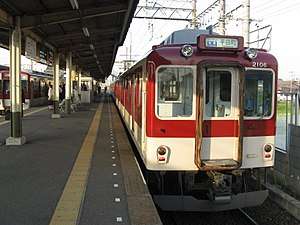Suzuka Line
The Suzuka Line (鈴鹿線, Kintetsu Suzuka-sen) is a railway line of the Japanese private railway company Kintetsu Railway, connecting Ise-Wakamatsu Station (Suzuka, Mie) and Hiratachō Station (Suzuka, Mie Prefecture) in Japan.
| Suzuka Line | |||||||||||||||||||||||||||||||||||||||||||||||||||||||||||||||||||||||||||||||||||||||||||||||||||||||||
|---|---|---|---|---|---|---|---|---|---|---|---|---|---|---|---|---|---|---|---|---|---|---|---|---|---|---|---|---|---|---|---|---|---|---|---|---|---|---|---|---|---|---|---|---|---|---|---|---|---|---|---|---|---|---|---|---|---|---|---|---|---|---|---|---|---|---|---|---|---|---|---|---|---|---|---|---|---|---|---|---|---|---|---|---|---|---|---|---|---|---|---|---|---|---|---|---|---|---|---|---|---|---|---|---|---|
| L | |||||||||||||||||||||||||||||||||||||||||||||||||||||||||||||||||||||||||||||||||||||||||||||||||||||||||
 Local bound for Hiratachō | |||||||||||||||||||||||||||||||||||||||||||||||||||||||||||||||||||||||||||||||||||||||||||||||||||||||||
| Overview | |||||||||||||||||||||||||||||||||||||||||||||||||||||||||||||||||||||||||||||||||||||||||||||||||||||||||
| Type | Commuter rail | ||||||||||||||||||||||||||||||||||||||||||||||||||||||||||||||||||||||||||||||||||||||||||||||||||||||||
| Locale | Suzuka | ||||||||||||||||||||||||||||||||||||||||||||||||||||||||||||||||||||||||||||||||||||||||||||||||||||||||
| Termini | Ise-Wakamatsu Hiratachō | ||||||||||||||||||||||||||||||||||||||||||||||||||||||||||||||||||||||||||||||||||||||||||||||||||||||||
| Stations | 5 | ||||||||||||||||||||||||||||||||||||||||||||||||||||||||||||||||||||||||||||||||||||||||||||||||||||||||
| Operation | |||||||||||||||||||||||||||||||||||||||||||||||||||||||||||||||||||||||||||||||||||||||||||||||||||||||||
| Opened | December 20, 1925 | ||||||||||||||||||||||||||||||||||||||||||||||||||||||||||||||||||||||||||||||||||||||||||||||||||||||||
| Operator(s) | Kintetsu Railway | ||||||||||||||||||||||||||||||||||||||||||||||||||||||||||||||||||||||||||||||||||||||||||||||||||||||||
| Technical | |||||||||||||||||||||||||||||||||||||||||||||||||||||||||||||||||||||||||||||||||||||||||||||||||||||||||
| Line length | 8.2 km (5.1 mi) | ||||||||||||||||||||||||||||||||||||||||||||||||||||||||||||||||||||||||||||||||||||||||||||||||||||||||
| Number of tracks | 1 | ||||||||||||||||||||||||||||||||||||||||||||||||||||||||||||||||||||||||||||||||||||||||||||||||||||||||
| Track gauge | 1,435 mm (4 ft 8 1⁄2 in) | ||||||||||||||||||||||||||||||||||||||||||||||||||||||||||||||||||||||||||||||||||||||||||||||||||||||||
| Electrification | Overhead, 1,500 V DC | ||||||||||||||||||||||||||||||||||||||||||||||||||||||||||||||||||||||||||||||||||||||||||||||||||||||||
| Operating speed | 80 km/h (50 mph) | ||||||||||||||||||||||||||||||||||||||||||||||||||||||||||||||||||||||||||||||||||||||||||||||||||||||||
| |||||||||||||||||||||||||||||||||||||||||||||||||||||||||||||||||||||||||||||||||||||||||||||||||||||||||
The line connects with the Nagoya Line at Ise-Wakamatsu Station.
Students and factory workers make up the majority of the line's ridership and trains are generally only crowded during rush hour.
History
Kambe Line
The Suzuka Line was originally built by Ise Electric Railway (Iseden) in the 1920s and was known as the Iseden Kambe Line (伊勢電神戸線, Iseden Kambe-sen)) and for many years the track ended at Ise-Kambe Station (what is now Suzukashi Station). Steam locomotives were used on the line for its first two years of operation but were soon replaced when the line was electrified in 1927. Though the line was built by Iseden, ownership of the Kambe Line was passed between various railway companies during the late 1930s and early 1940s due to many mergers occurring within the Japanese private railway industry at that time. It came under the ownership of Kintetsu in 1944.
Kintetsu made some improvements to the line in the late 1950s and 1960s. The track gauge on the line, originally 1,067 mm (3 ft 6 in) was widened to 1,435 mm (4 ft 8 1⁄2 in) so that it could connect directly with the Nagoya Line, also widened to 1,435 mm at that time. A few years later, the line was extended, two new stations were built, and Hiratachō Station became the new terminus. It was at this time that the line received its current name.
Timeline
- December 20, 1925 - Ise Railway (Iseden) opens the line as the Iseden Kambe Line (Ise-Wakamatsu ~ Ise-Kambe).
- December 26, 1927 - Electrification of the entire line completed.
- September 15, 1936 - Sangū Express Electric Railway (Sankyū) acquires Iseden and all of its lines. Line is officially renamed Ise Kambe Line.
- March 15, 1941 - Osaka Electric Railroad (Daiki) and Sankyū merge to form Kansai Express Railway (Kankyū). Line officially renamed Kambe Line.
- June 1, 1944 - Kankyū changes its name to Kinki Nippon Railway (Kintetsu). Line officially renamed Kintetsu Kambe Line.
- November 23, 1959 - Gauge along entire line widened from 1067 mm to 1435 mm.
- April 8, 1963 - Ise-Kambe ~ Hiratachō extension opens. Ise-Kambe Station officially renamed Suzukashi Station. Line officially renamed Kintetsu Suzuka Line.
- October 17, 1968 - ATS system activated on entire line.
- March 16, 1995 - Maximum speed on the line raised from 65 to 80 km/h (40 to 50 mph); total ride time from end-to-end reduced by one minute.
- June 13, 1998 - One man (conductor-less) train service begins.
Service
LO Local (普通; futsū)


- (Locals stop at every station.)
- (Trains run twice per hour during the day, four times per hour in the mornings and evenings.)
EX Express (急行; kyūkō)
Stations
| Legend | |
|---|---|
| ● | Trains stop here |
| Station | Dist (km) | Connections | LO | EX | Location | ||
|---|---|---|---|---|---|---|---|
| Ise-Wakamatsu | 伊勢若松 | 0.0 | Kintetsu: Nagoya Line | ● | ● | Suzuka | Mie Prefecture |
| Yanagi | 柳 | 2.2 | ● | ● | |||
| Suzukashi | 鈴鹿市 | 4.1 | ● | ● | |||
| Mikkaichi | 三日市 | 6.2 | ● | ● | |||
| Hiratachō | 平田町 | 8.2 | ● | ● | |||
References
- Kintetsu Line Archives - Suzuka Line (in Japanese)